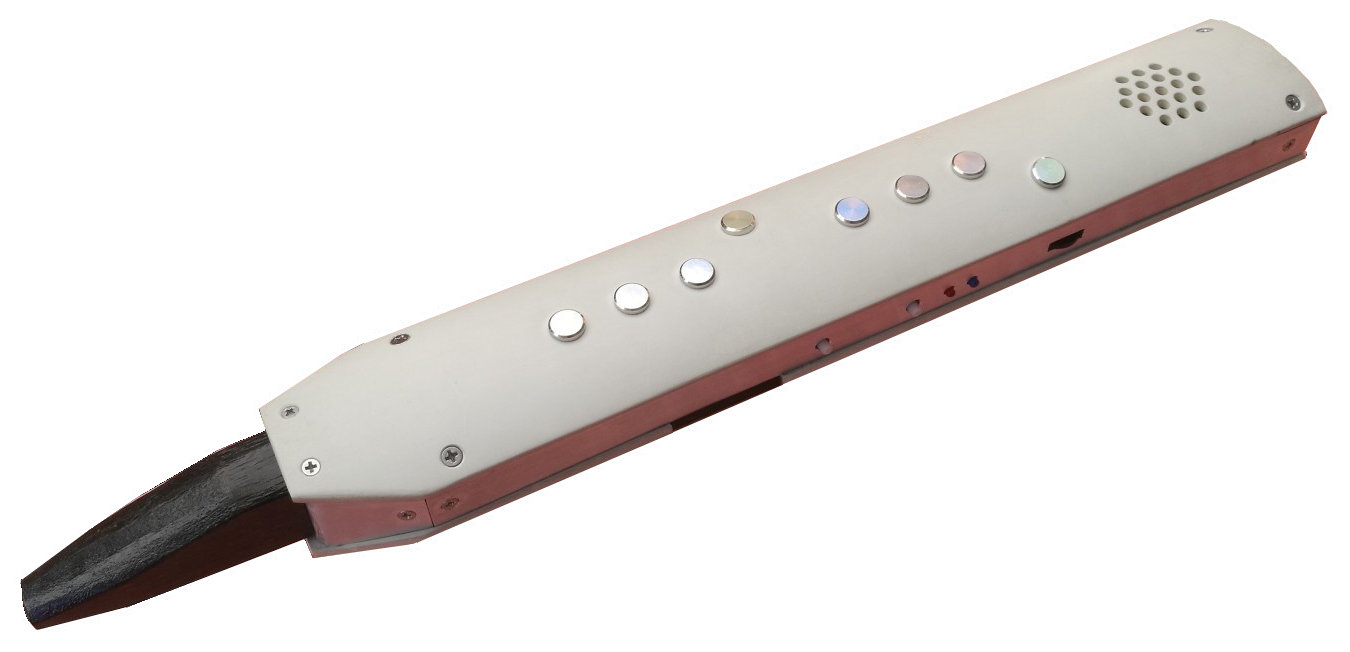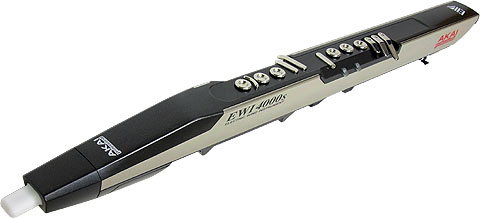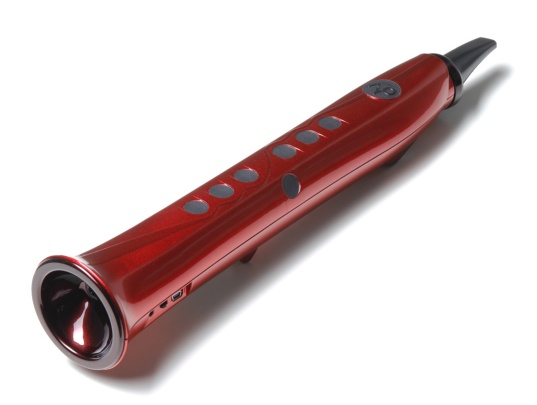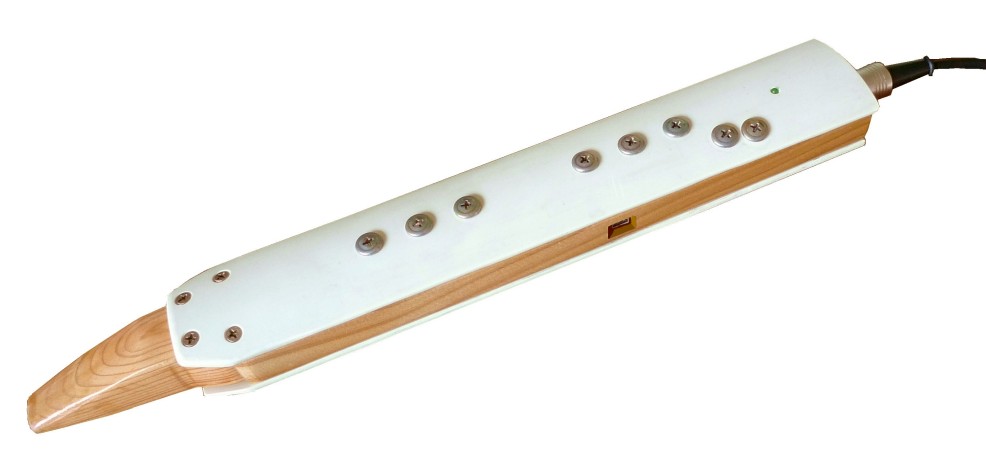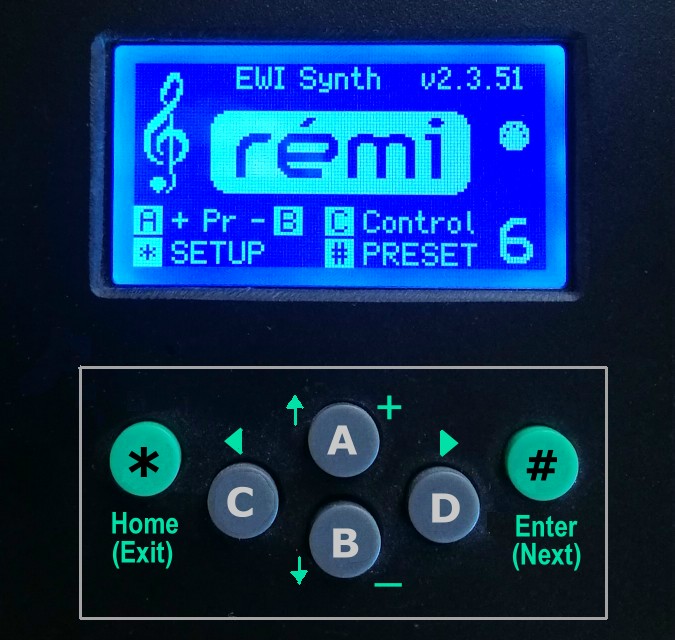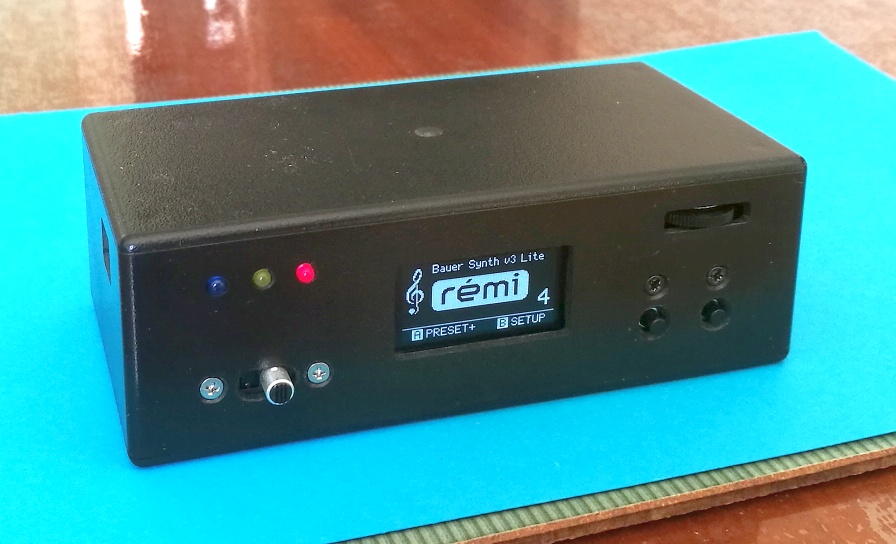|
Introducing the "REMI" by Michael J Bauer |
||||
|
REMI 3 prototype -- "All-in-One"
EWI |
||||
|
The "REMI" is an Electronic Wind Instrument (EWI) using a similar concept to commercial EWI's using touch-sensitive pads for the “keys” to select the pitch of notes. A breath pressure sensor allows notes to be articulated by blowing into a mouth-piece. REMI fingering schemes are based on the recorder, simplified to make it easier to play. REMI 3 (pictured) has a built-in sound synthesizer and speaker. Most electronic instruments are designed to be played with a piano-style keyboard. However, wind instruments offer capabilities for musical expressiveness that a keyboard cannot, especially for lead parts. At first it might seem peculiar to blow air into an electronic instrument, but once you try it, the benefits become apparent. It's hard to understand why EWI's are not more popular. They have such cool attributes! Although an EWI can emulate traditional wind instruments such as the flute, clarinet, saxophone, recorder, etc, the EWI should not be regarded as a substitute, but rather as a unique instrument in its own right. EWI's are easier to play than their acoustic counterparts. Moreover, electronic instruments can transpose the pitch to any scale. And they don't need to be tuned. Perhaps some readers may be concerned that if they learn to play an EWI, it would be confusing to change to an acoustic instrument. Such concerns are not justified. Consider that many musicians switch between different wind instruments during a performance, sometimes within the same piece of music. Sure, wind instruments have differences in their fingerings, but they also have much in common. With practise, the brain adapts to the differences. There's not a great selection of commercial EWI's available and the better ones are expensive, for example the Akai model EWI-4000S and the Aodyo "Sylphyo". A major objective of the REMI project is to provide a low-cost alternative which will appeal to beginners taking up a new musical instrument.
A commercial EWI with integral sound synth: Akai EWI-4000s *
So-yeon blows a vintage Akai
EWI 1000 * How do EWI's produce sound? While the instrument is played, analogue signals from the touch-pads, breath pressure sensor and other player controls are converted to a digital data stream, typically using the MIDI message protocol. The data stream is fed into a sound synthesizer of some kind. The synthesizer outputs an audio signal to an amplifier, in similar manner to other electronic instruments. Some EWI's combine the player controls and the sound synthesizer into a single apparatus, which may be battery-powered, requiring only an audio connection to external equipment, or headphones. The REMI 3 falls into this category, but it also has a built-in amplifier and speaker for true stand-alone playability. Other EWIs are composed of two separate parts: a "hand piece" comprising the player controls, plus a "sound module" containing the synthesizer, power supply, and maybe audio effects and power amplifier, etc.
Akai EWI-3030m Sound Module * If the EWI "hand piece" makes provision for a MIDI-USB adapter/cable, the external "sound module" can be a computer or mobile device running a sound synthesizer application. There's a plethora of "VST" synth app's available out there, many freeware, to download. As with electronic keyboard synthesizers, an EWI sound module or computer VST "synth app" is capable of generating a broad variety of instrument sounds. In contrast, acoustic instruments produce just one characteristic sound. But synthesizers vary greatly in their ability to emulate acoustic instruments. Synthesizers designed specifically for EWI's generally provide better expressiveness and control over the subtle nuances intrinsic to wind instruments.
The "Respiro" virtual synthesizer uses physical modeling software * Pitch-bend, effect modulation and other nuances Acoustic instruments allow the player to vary the volume, pitch and timbre (harmonic content) of the sound by varying the breath pressure and, in the case of reeded instruments, by varying the lip force applied to the reed. In the hands of an expert musician, playing techniques can produce a range of pleasing effects to augment the performance. Mastery of a real wind instrument is hard to achieve because the effects interact. For example, with a recorder or flute, increasing the breath pressure will raise the pitch of the note slightly. But this will increase the volume as well, of course. And it also changes the timbre of the note. If the player blows too hard, an unpleasant squeaky sound may be produced. Similarly, the manner in which the reed of a clarinet, oboe or saxophone is blown (termed "embouchure") can produce a variety of effects, not always as intended. It takes a lot of practice to obtain the desired sound effects and to avoid the unwanted side-effects. Although electronic instruments cannot match acoustic instruments for sheer musical expressiveness, EWI's have distinct advantages, particularly favorable to learners. An EWI may be configured so that the volume, pitch and timbre of the sound are controlled independently. Typically, breath pressure determines the volume and timbre; a pitch-bend mechanism of some sort (e.g. a moveable mouthpiece) controls variation in pitch and a "modulation lever" (or pad, wheel, slider, etc) varies some other effect. But these sensor assignments are arbitrary and may be re-assigned at will by the player. For example, breath pressure may be set up to control only volume; the modulation lever may be assigned to control vibrato depth, timbre, noise level, celeste (oscillator detune), or whatever else is supported by the synth. An EWI synthesizer may be set up so that it mimics closely the characteristics of an acoustic instrument. Some "high-end" (expensive!) EWI sound modules use a synthesis technique called "physical modeling" (aka "acoustic modeling") to reproduce accurately the sound properties of acoustic instruments. Conversely, synthesizers can also produce sounds that are entirely different and impossible to produce with any acoustic instrument. This is one of the main attractions of electronic instruments.
The "Sylphyo" has an abundance of sensors for uncompromised expressiveness... at a price * Octave selection and overall pitch range Another advantage of EWI's over their acoustic counterparts is their method of octave selection. Octave selection in acoustic instruments is made by the overall fingering pattern, so that the player needs to learn at least one unique fingering for every note in the overall range of the instrument. In general, the fingering of a particular note in one octave differs from the same note in another octave. By contrast, octave selection in an EWI is far simpler. In the majority of EWI designs, including the REMI, octave selection is made by moving the left-hand thumb, while a note within the octave is selected by the fingers. This means that EWI players need to learn only 12 fingering patterns corresponding to the 12 notes (semitones) covering an octave. Some EWI's, including REMI, extend the range of notes covered without changing the octave selection. EWI designs vary in the number of octaves covered. Akai EWI's use a mechanism called the "octave roller" which is really just a row of touch-pads in the form of small wheels over which the thumb glides. The centre position selects the middle octave. Moving the thumb up or down the roller raises or lowers the pitch by one or two octaves, giving an overall range of 5 octaves. The octave roller scheme has a reputation for being somewhat quirky. The REMI has 3 thumb positions so that the pitch can be raised or lowered by one octave from the middle octave. However, the REMI's fingering scheme provides an overall range of four octaves. For comparison, a guitar has a range of 3-and-a-bit octaves. Fingering Schemes REMI offers a choice of fingering schemes, all based on the recorder. The REMI standard fingering scheme was designed to be easy to learn. The player needs to learn only the finger positions of 12 notes in one octave. This scheme is best for beginners learning to play an EWI. An alternative fingering scheme has a pad located at LH4 instead of RH5. Pad LH4 sharpens certain notes, i.e. C and F. The scheme was implemented in the REMI for compatibility with some other EWI’s. A Baroque fingering scheme is also supported by the REMI 2 firmware. This scheme provides realistic emulation of modern acoustic recorders, both English and German. Pad RH5 serves to emulate "half hole" fingering of pad RH4. The octave pads emulate "full hole" and "half hole" operation with the left-hand thumb. The overall range of notes is two-and-a-half octaves using this scheme. For details of fingering options, with charts, please refer to the REMI 2 User Manual. REMI model 3 features
REMI model 2 REMI 2 is simply a MIDI controller with standard MIDI OUT connection (5-pin DIN socket). It does not have a built-in sound synthesizer, so it must be plugged into an external MIDI sound module or keyboard synth. Or it can be used to control a PC software synth using a USB-MIDI adapter. How to obtain a REMI There are no plans for commercialisation, but if there is sufficient expression of interest from readers, a limited quantity may be produced for sale. REMI model 2 (EWI MIDI controller), the REMI Sound Synth Module and REMI 3 (All-in-One EWI) prototype designs are presented here for DIY electronics hobbyists who are capable of building their own. Circuit boards and custom enclosures may be produced to make construction easier. Links to design and construction notes for DIY electronics hobbyists:
|
||||
|
The author welcomes expressions of interest from readers, in particular those willing to help with further development or production (e.g. PCB design, 3D printed enclosure). Also be sure to notify me if you're interested in buying a REMI or a kit of parts for DIY. Last update: 04-NOV-2023 * Photos
courtesy Google Images (Copyrights ignored) |
